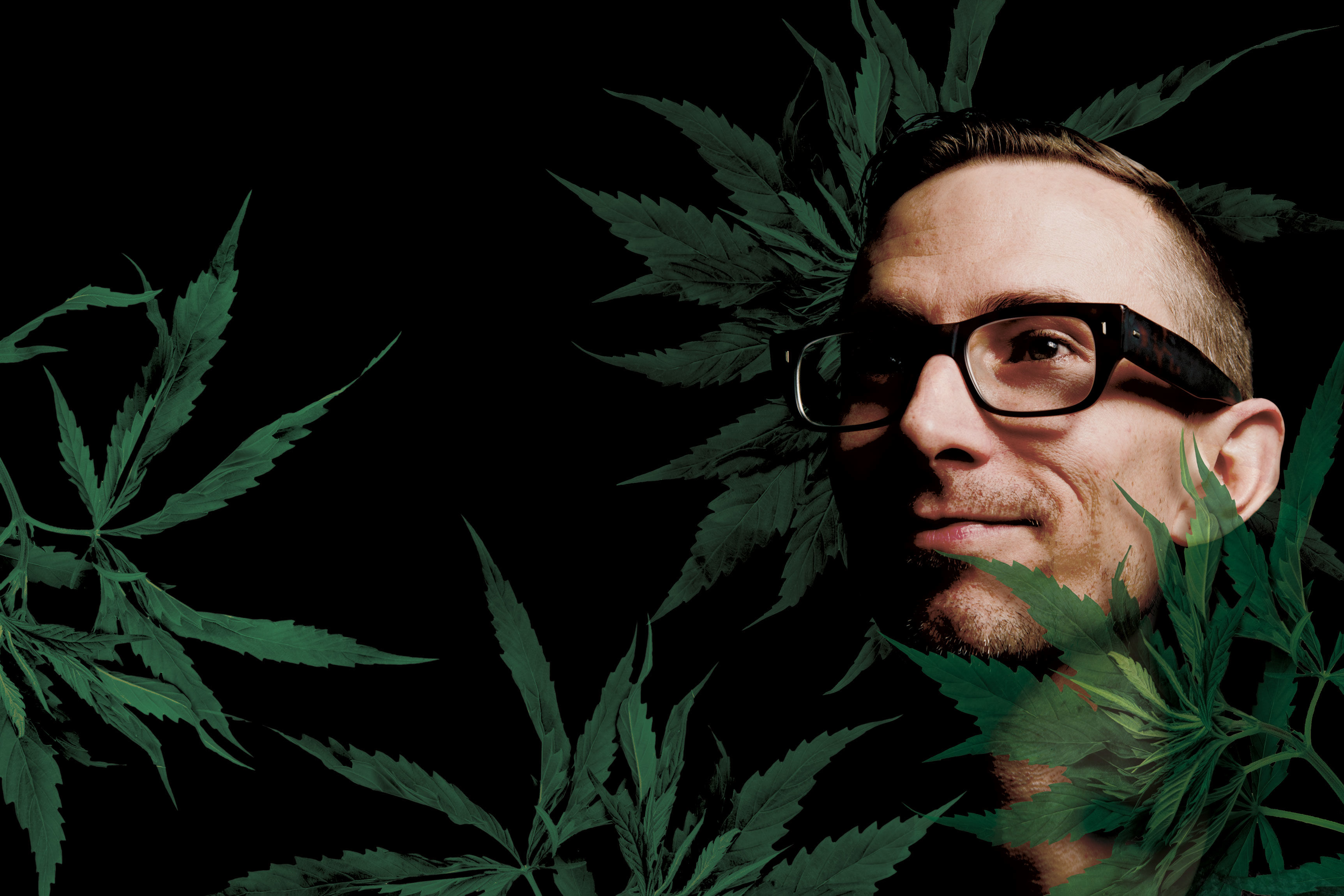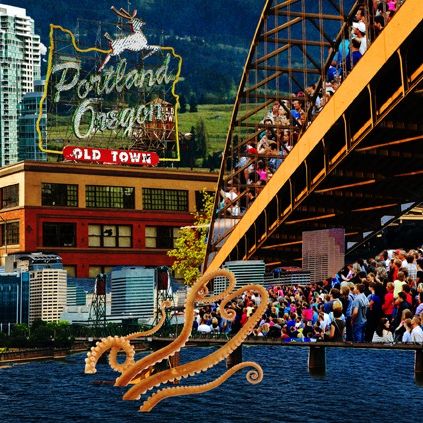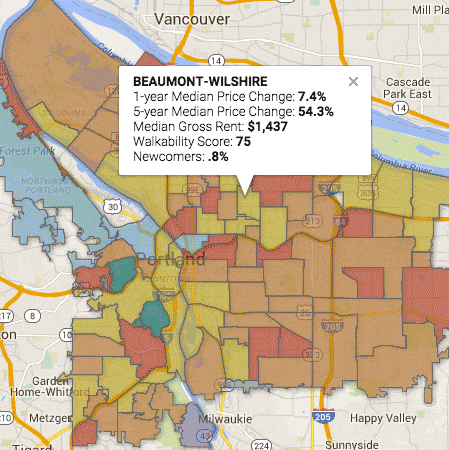
Is This the Future of Weed?
Jeremy Plumb’s parents split up when he was 3. His father worked in human resources, at a pharmaceutical company. His mom married a major marijuana trafficker. The contrast left Plumb, who was born in a small Colorado mountain community but grew up in California’s Sonoma County, equally uneasy with modern medicine’s pharmaceutical remedies and with the marijuana black market’s fixation on profit.
One chilly day in January, Plumb, now 39, surveyed the place he sees as the perfect bridge between those two worlds: Farma, a Southeast Portland cannabis dispensary that gleams like an upscale pharmacy. No black lights, no Rastafarian flags on the wall; just clean glass cases displaying some of the highest-quality marijuana sold in Portland. And while it’s a bit superficial to size up Farma just by looking at its clientele, look at them, Plumb insists. Old and young, they wear Portland flannels and business-class coats, carry professional briefcases and purses, and sport sharp haircuts. Any Big Pharma company would be happy to sell them little pills. If there is such a thing as “normal people,” Plumb’s customers look like normal people. Their collective affect evokes the earnest and informed consumers you might spot at New Seasons or Powell’s rather than the glassy-eyed stoners of yore, pontificating on the universe beneath Bob Marley posters (not that there’s anything wrong with that).
By their very presence, these customers fulfill Plumb’s ambition: to reinvent everything about marijuana, starting with who uses it, and how, and why. Research suggests that even in this era of slow-rolling, state-by-state legalization, heavy cannabis users consume most of the marijuana now smoked or vaporized or eaten in the US. Farma’s regulars represent a tantalizing departure from stereotype, Plumb promises. Maybe they smoked pot decades ago, in college. Maybe they got high for the first time last week. Maybe they’re here not to get high at all, but because they heard cannabis can relieve headaches, anxiety, PMS, and back pain.
And while the commercial scene taking shape in Portland since recreational marijuana sales began in Oregon on October 1, 2015, offers no shortage of shops attempting to transcend weed stereotypes with new age-y names and spa-style branding and décor, Plumb aspires to something more. He’s devised a system of cannabis analysis that he claims offers Farma an unparalleled means of understanding how the many different strains of marijuana actually work: how Purple Alien Dawg, say, might affect a consumer differently than Sour Diesel. Plumb doesn’t put much stock in the modern weed industry’s crazed profusion of branded breeds to begin with—though Farma does sell varietals with party-ready names like Golden Goat, Jilly Bean, and 3x Crazy. He says strains are often mislabeled for marketing purposes. Nor does he find much use in the traditional division—subject of dorm-room wisdom since time immemorial—between “indica” (said to induce sluggishness, and perhaps the choice for a session of vintage Rush on headphones) and “sativa” (better, perhaps, for giggly euphoria and Broad City binge-watching). Plumb believes that even the more evolved descriptors now common parlance in booming recreational markets like Portland, Seattle, and Denver—typically, measures of tetrahydrocannabinol (THC) versus cannabidiol (CBD)—can mask the true complexity of pot’s potential.
“As long as cannabis is poorly measured, it will never be taken seriously in the health care community, and patients will never be able to rely on consistent outcomes,” Plumb says. “The compounds cause the therapeutic benefit.”
To address the problem, Plumb has devised a proprietary algorithm based on chemotypes, the precise chemical composition of particular strains. He sends samples of all the pot he sells to a lab, which returns an exacting description of each specimen laid out beneath Farma’s glass-topped counters. Those descriptions are based on the lab’s analysis of 64 compounds found in the plant—compounds research has shown to affect consumers both psychologically and medicinally.
Plumb then weaves those results into his algorithm which, he says, produces a sophisticated but easy-to-understand rating system. Whereas other dispensaries tend to describe the complex plant in bong-culture jargon—this one’s more “psychoactive” and “giggly,” this one’s more “stony” and binds you to the couch—Farma places each of the strains it carries on a spectrum from mildly to strongly sedating or euphoric. The spectrum is described with a simple, visual illustration, a red (focusing and euphoric) or a blue (relaxing and calming) rectangle, with a white dot placed anywhere from the left, for low intensity, or the right, for high.
The shop also offers details on the plants’ cultivation. Golden Goat, for example, was produced by Newcleus Nurseries and grown in “living organic soil.” It has a total “terpene output” of 7.6 percent. (Terpenes, in cannabis, are associated with both aromas and therapeutic efficacy.) Farma’s budtenders, who help with both the handling and the sale of the products, are armed with a binder of information about cannabidiol levels and specifics from the lab reports. Plumb or one of his employees gently probes what a customer seeks, and makes recommendations to match.
The result is a consumer experience somewhere between a wine tasting and a visit to a medical specialist. “It’s a modern, informative, designer-cannabis boutique,” says John Bayes, a Portland grower and friend of Plumb’s.
Individual results may vary, of course; marijuana is a complex plant, cultivated for millennia, and humans are even more complex. But by inching closer to a more sophisticated understanding of how marijuana affects people, Plumb and his co-owners—Sam Heywood, Steve Bennett, and Paul Neidergang—hope to help those who might have written off pot a long time ago rediscover the plant’s healing, relaxing, and creativity-enhancing virtues. It’s good for business, naturally, this broadening of Plumb’s potential customer base. To spend five minutes with Plumb is to realize how passionate he is about marijuana as an alternative to so many of the methods we use to cure illness or calm our minds.
“I don’t want people to just come here and buy things,” Plumb says. “I want them to be transformed. If this just becomes another shop, I will walk away.”
Plumb grew up with chronic sinusitis, the byproduct of an inherited asthma that has debilitated his father for decades. (To this day, his dad takes a dozen different medications for allergies and asthma.) In high school, the self-described “music nerd”—he played violin, bass guitar, and piano and composed electronic music—bought off bullies with weed pilfered from his stepdad. He started growing pot when he was 15. In 2000, after earning a degree in cultural ecology from the New College of California, he moved to Portland to study counseling at the Process Work Institute and, ultimately, obtain a “depth psychology” degree from Pacifica Graduate Institute. (Both institutions have roots in Jungian theory.)
Gaunt and wiry, with animated eyes peering out from black-framed glasses, Plumb worries about the effect those drugs have had on his dad, which is in part why he has increasingly looked to cannabis as medicine. (Cannabis has been shown to help dilate the bronchial cords, for example, which Plumb believes could help with his father’s asthma.) That’s not to say that he rejects modern medicine. Just after moving to Portland in 2000, Plumb got a sinus infection, a recurring ailment since he was young. This one lasted nine years, ultimately requiring an 11-week course of antibiotics.
But for other maladies—migraines and anxiety, chiefly—pot was a better choice, he says. As states like Colorado, Washington, and eventually Oregon edged closer and closer to legalization, Plumb realized he was well positioned to start a medical dispensary.
Plumb doesn’t see cannabis as a panacea. But he does believe the popular perception of the plant has been warped by decades of widespread overconsumption. By urging people to experiment with the tiniest of doses of cannabis—a single hit, to start, or a low-dose edible—and by presenting a sophisticated means of describing particular strains’ effects, Plumb hopes to transform how marijuana is viewed and consumed, and to reverse the persistent stigma and stereotypes attached to using it.
Plumb’s dispensary surely isn’t the only shop in Portland, or the world, run by people who understand that marijuana is a complex plant. But his laboratory analysis of the strains he carries, and the descriptive system he has developed based on that data, can be found nowhere else. And even as it evolves in states that have legalized recreational use, the industry remains bogged down in old symbolism and lore steeped in bongwater. Plumb envisions a world where people enjoy reasonable amounts of cannabis with reliable effects, much as we can predict how a single glass of red wine will make us feel. He says the key to ending federal prohibition is to help everyday Americans discover how to use pot in a healthier way. With every step in that direction, researchers and scientists will feel more confident in investing resources (and reputations) in studying cannabis and its all-too-often-mythologized potential. These are lofty goals, but Plumb is convinced he’s on his way.
“This is one of the most benign, therapeutically active substances on the planet,” Plumb says. “We live in this culture of excess that frames cannabis as an intoxicant. Cannabis culture is its own worst enemy. Our conviction is that all these compounds are working in synergy. This should be a pharmacy. A clinic. That’s what I’m trying to do here.”
Before Oregon voters legalized recreational pot, Farma focused on cannabis as medicine, not as a way to better enjoy a concert or a conversation. Now, the dispensary can broaden its appeal to a much wider audience. Both his friends and his competitors say that within the industry, Plumb is a one-of-a-kind thinker.
“Jeremy is the sage of the Oregon cannabis world,” says Mowgli Holmes, a Portland biologist who is mapping the plant’s genome and who works with Plumb on a variety of projects. “Some people are more into it than others. But Jeremy has a vision for the future. He’s a sommelier of pot, and he smokes in very small amounts, incredibly attuned to all of its subtleties.”
If Plumb has his way, cannabis culture will shift from Doritos-binge jokes to a respected alternative for an overmedicated society. (“I’d like to see fewer opioid-related overdoses,” he notes.) For now, says Holmes, Plumb is an outlier in an industry focused on profits and getting people stoned. “The way Jeremy is going will carry the day,” he says. “The high-end market will follow his lead.”
And, just maybe, all those “normal” customers will discover a new way to feel better thanks to humanity’s old friend, the cannabis plant.














